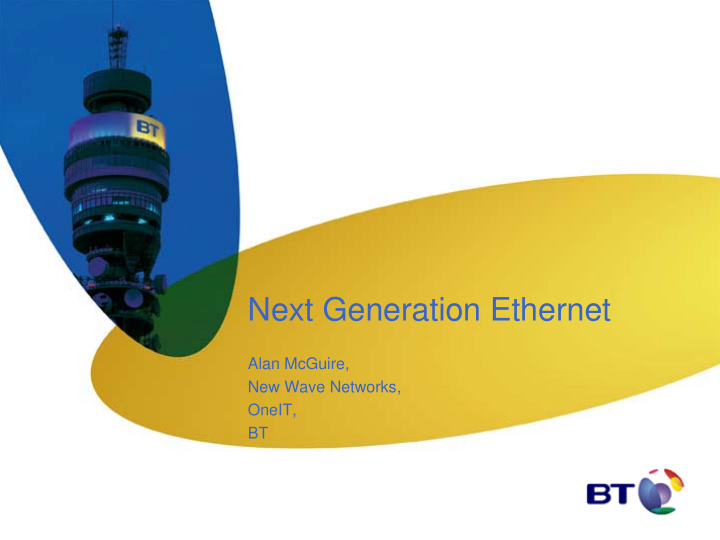



Next Generation Ethernet Alan McGuire, New Wave Networks, OneIT, BT
Enterprises • Enterprises look to scale a single community of interest – They are their own customer • Which may range in size from a small number of desktops to an international corporate network • Networks frequently constrained to geographically small and quite dense “islands” – Large networks have IT support in close proximity • Controls on behavior of the community implemented within a single layer – Community is in general well behaved – IT has access to and control of all network components • Simple east-west “discovery” sufficient for small networks to operate – Customer typically provided unfettered access to network
Carriers • Carriers look to scale many small communities of interest – A carrier has many customers – “Small” is relative, customer networks can be quite large • Customers need to be isolated from each other as well as the carrier’s network – Both with respect to connectivity, and with respect to resource consumption – This requires the carrier partition the network both vertically and horizontally • The network cannot have common failure modes • Equipment rather sparsely geographically distributed – Outside plant, unattended offices etc. – Support frequently not in close proximity and expensive to dispatch – Carrier does not control, nor have access to all network components • Complicates addressing malicious or incompetent customers • Carriers need reliable population of inventory – Relationship between carrier inventory and customer access is a business decision – Poor data fill for un-automated systems is a major barrier to service fulfillment – Nodal discovery, neighbor discovery and population of inventory is a much different problem than that of simple “east-west” flooding
Drive to commonality between Carriers and Enterprise • Reach of optics – No dependency on line systems for reach in the LAN and MAN • Leveraging economies of scale – Evolving to a common technology base • Enterprise kit gradually gaining carrier functionality – Dataplane and management tools • Ethernet – Ubiquity in Enterprise & the home • Wireless, LAN, MAN, WAN – Introduction of Ethernet Services (E-Line, E-LAN, E-VLAN,…..) – Interface of choice for many
General Requirements Interconnect • Regulatory obligations Ethernet Switches Multiservice Platform • Multiservice Access • Low cost per Gbit/s • Common design and vendor • Standards compliant solution • Wide source of supply • Avoid vendor lock-in • Single OSS • QoS Model • OAM Model Interconnect Interface End User Interface Carrier Class Operation • Defined services • Scalable • OAM and remote operations Support for Full Range of • Mesh topology and restoration Services mechanisms • Voice Control/OSS Systems • In service operations and upgrade • Broadband • Transport model • IP VPN access • Option of ASON control plane • VPLS access • Ethernet • ATM, FR
PBT As A Carrier Grade Solution • Turn off MAC learning, Broadcast Unknown and STP – Use MAC-in-MAC hierarchy to separate customers from the carrier network, – and add hierarchical dataplane OAM for instrumentation and protection. • Place under a Carrier-grade Management system – and introduce auto-discovery within the carrier network itself • Management sets up connections, populating switch bridging tables : – Flows are separated using VLAN tags, which allows traffic management. – Tags not swapped, only significant per destination (not a scaling limitation) Service and Network Management SA: PE1 MiM MiM DA: PE3 de-encapsulation encapsulation VLAN 45 Customer Customer Network Network SA: PE1 DA: PE3 VLAN 44
Comparing Bridge Learning and PBT Bridge Learning PBT 1. Spanning Tree Protocol prunes 1. End points register MAC links to logical tree addresses with network control 2. Broadcast unknown destination 2. Network control authorises Network address (blue) and learn port of MAC address and records Controller unknown source address (red) topological location Connection 3. Forward to learnt destination 3. Connection request request address (red) learn port of unknown 4. Network control makes source address (blue) forwarding entries Pruned link
Forwarding Mode •Wide variety of buffering algorithms • External implemented by population of vendors forwarding table •8 level priority queue • Forwarding table control by VLAN maps tuple of DA priority bits required Forwarding Table and VLANiD to by 802.1q an egress port •DA:VLAN available DA:VLANiD Port • Drop packet on for individual flow or DA:VLANiD Port no forwarding aggregate flow DA:VLANiD Port default drop table entry queuing algorithms Buffer PHY PHY Egress Ports Ingress Ports Buffer PHY PHY Buffer PHY PHY Buffer PHY PHY
Transport Service Types DA SA VLAN* ET/Len payload (6) (6) (4) (2 or 4) *VLAN header is VLAN Ethertype (8080) and VLAN Field Header Field Meaning in PBT Destination MAC Provider unique label of Address (48 bits) destination Source MAC Address Provider unique label of source and (de-)multiplex (48 bits) label VLAN Id Route/path/trail discriminator* (VLAN header) (12 bits) Priority Forwarding priority marking (VLAN Header) (3 bits) Ethertype (ET) Protocol in payload (16 bits) * Uses of the VLANId route discriminator include • Distinguishing separated paths for protection • Traffic engineering • Multiplexing multiple channels between two end points
Conclusions • Enterprise and Carrier worlds are colliding – Lots of commonalities but there are also big differences – Enterprise wants plug and play – Carriers require determinism • Hierarchy and encapsulation allow both to exist – Mac-in-Mac from IEEE provides scalable solution • PBT is an example of a technology that achieves this
Recommend
More recommend